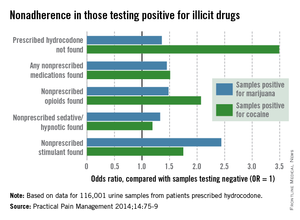For chronic pain patients who are prescribed opioids, nonadherence rates are increased among marijuana users and can be as high as or higher than rates in cocaine users, according to a review of a commercial urine drug monitoring database.
Of 116,001 samples submitted to Ameritox for patients prescribed hydrocodone, 29% contained marijuana and a nonprescribed medication and 30% contained cocaine and a nonprescribed medication. Of those with no illicit drug found, 22% had a nonprescribed medication, reported Michael DeGeorge Jr., Pharm.D., and Eric Dawson, Pharm.D., who were both associate directors of medical affairs at Ameritox, a pain medication monitoring laboratory, at the time of the study. Dr. DeGeorge is now director of medical affairs for the company.
Among samples testing positive for marijuana, 37% did not contain the prescribed hydrocodone, compared with 60% of samples positive for cocaine and 30% of those containing no illicit drugs, the investigators said (Pract. Pain Manage. 2014;14:75-9).
The review also showed that, when compared with samples containing no illicit drugs, those from marijuana users were more likely to contain a nonprescribed opioid (odds ratio, 1.48; 2.07 for cocaine), a nonprescribed sedative/hypnotic (OR, 1.33; 1.19 for cocaine), and a nonprescribed stimulant (OR, 2.44; 1.75 for cocaine), Dr. DeGeorge and Dr. Dawson noted.
"These results indicate that marijuana use should be explored via UDM [urine drug monitoring] in chronic pain patients prescribed opioids. For clinicians who continue to prescribe opioids even if UDM confirms the use of marijuana, this [study] suggests that these patients should be considered at higher risk of medication misuse than patients not using illicit drugs," they wrote.
Such high-risk patients, they added, may warrant "more frequent follow-up, including the use of clinical tools such as prescription drug monitoring programs and more frequent urine drug testing." This recommendation is consistent with recent guidelines from the American Society of Interventional Pain Physicians (Pain Physician 2012;15:s1-s65) and the American Pain Society and the American Academy of Pain Medicine (J. Pain 2009;10:113-30).
The review involved samples submitted to Ameritox from May 16, 2011, to May 15, 2012. Samples were included if physicians requested testing for both marijuana and cocaine. Of the 116,001 samples eligible for inclusion, 85% (99,115) had no illicit drugs present, 13% (15,153) were positive for marijuana only, and 2% (1,731) were positive for cocaine only, Dr. DeGeorge and Dr. Dawson said.


